On the Effect of Red Sea and Topography on Rainfall over Saudi Arabia: Case Study
Abstract
1. Introduction
2. Data and Methodology
2.1. Data Used
2.2. WRF Description, Configuration, and Experimental Setup
3. Synoptic Discussion of the Case Study
4. Results and Discussion
4.1. Control Run Investigation
4.2. Sensitivity Experiments
4.2.1. The Simulated Rainfall Patterns
4.2.2. The Simulated Synoptic Patterns
4.2.3. Moisture Flux Variation
5. Remarks and Discussion
6. Conclusions
Author Contributions
Funding
Acknowledgments
Conflicts of Interest
References
- Ribó, M.; Llasat, M.C. Study of the impact of cyclogenesis at the Mediterranean Sea. In Proceedings of the 11th EGU Plinius Conference on Mediterranean Storms, Barcelona, Spain, 7–10 September 2009; Volume 11. Plinius-11-88. [Google Scholar]
- El-Fandy, M.G. The effect of the Sudan monsoon low on the development of thundery conditions in Egypt, Palestine and Syria. Q. J. R. Meteorol. Soc. 1948, 74, 31–38. [Google Scholar] [CrossRef]
- Abdeldym, A.; Basset, H.A.; Sayad, T.; Morsy, M. Kinetic energy budget and moisture flux convergence analysis during interaction between two cyclonic systems: Case study. Dyn. Atmos. Oceans 2019, 86, 73–89. [Google Scholar] [CrossRef]
- Haggag, M.; El-Badry, H. Mesoscale numerical study of quasi-stationary convective system over Jeddah in November 2009. Atmos. Clim. Sci. 2013, 3, 73–86. [Google Scholar] [CrossRef]
- Hasanean, H.; Almazroui, M. Rainfall: Features and Variations over Saudi Arabia, a Review. Climate 2015, 3, 578–626. [Google Scholar] [CrossRef]
- Almazroui, M.; Raju, P.V.S.; Yusef, A.; Hussein, M.A.A.; Omar, M. Simulation of extreme rainfall event of November 2009 over Jeddah, Saudi Arabia: The explicit role of topography and surface heating. Theor. Appl. Clim. 2018, 132, 89–101. [Google Scholar] [CrossRef]
- De Vries, A.J.; Tyrlis, E.; Edry, D.; Krichak, S.O.; Steil, B.; Lelieveld, J. Extreme precipitation events in the Middle East: Dynamics of the active Red Sea trough. J. Geophys. Res. Atmos. 2013, 118, 7087–7108. [Google Scholar] [CrossRef]
- El Kenawy, A.M.; McCabe, M.F.; Stenchikov, G.L.; Raj, J. Multi-decadal classification of synoptic weather types, observed trends and links to rainfall characteristics over Saudi Arabia. Front. Environ. Sci. 2014, 2, 37. [Google Scholar] [CrossRef]
- Deng, L.; McCabe, M.F.; Stenchikov, G.; Evans, J.P.; Kucera, P.A. Simulation of Flash-Flood-Producing Storm Events in Saudi Arabia Using the Weather Research and Forecasting Model. J. Hydrometeorol. 2015, 16, 615–630. [Google Scholar] [CrossRef]
- McGinley, J.; Goerss, J. Effects of terrain height and blocking initialization on numerical simulation of Alpine lee cyclogenesis. Mon. Weather. Rev. 1986, 114, 1578–1590. [Google Scholar] [CrossRef]
- Dell’Osso, L. High-resolution experiments with the ECMWF model: A case study. Mon. Weather. Rev. 1984, 112, 1853–1884. [Google Scholar] [CrossRef]
- Hughes, M.; Hall, A.; Fovell, R.G. Blocking in areas of complex topography, and its influence on rainfall distribution. J. Atmos. Sci. 2009, 66, 508–518. [Google Scholar] [CrossRef]
- Ntwali, D.; Ogwang, B.; Ongoma, V. The Impacts of Topography on Spatial and Temporal Rainfall Distribution over Rwanda Based on WRF Model. Atmos. Clim. Sci. 2016, 6, 145–157. [Google Scholar] [CrossRef]
- Enyew, B.D.; Steeneveld, G.J. Analysing the Impact of Topography on Precipitation and Flooding on the Ethiopian Highlands. J. Geol. Geosci. 2014, 3, 1–6. [Google Scholar] [CrossRef]
- Al-Khalaf, A.K.; Abdel Basset, H. Diagnostic study of a severe thunderstorm over Jeddah. Atmospheric and Climate Sciences 2013, 3, 150–164. [Google Scholar] [CrossRef][Green Version]
- Almazroui, M. Sensitivity of a regional climate model on the simulation of high intensity rainfall events over the Arabian Peninsula and around Jeddah (Saudi Arabia). Theor. Appl. Clim. 2011, 104, 261–276. [Google Scholar] [CrossRef]
- Dee, D.P.; Uppala, S.M.; Simmons, A.J.; Berrisford, P.; Poli, P.; Kobayashi, S.; Andrae, U.; Balmaseda, M.A.; Balsamo, G.; Bauer, P.; et al. The ERA-interim reanalysis: Configuration and performance of the data assimilation system. Q. J. R. Meteorol. Soc. 2011, 137, 553–597. [Google Scholar] [CrossRef]
- Huffman, G.J.; Adler, R.F.; Bolvin, D.T.; Nelkin, E.J. The TRMM multi-satellite precipitation analysis (TMPA). In Satellite Rainfall Applications for Surface Hydrology; Springer: Dordrecht, The Netherlands, 2010; pp. 3–22. [Google Scholar]
- Chawla, I.; Osuri, K.K.; Mujumdar, P.P.; Niyogi, D. Assessment of the Weather Research and Forecasting (WRF) model for simulation of extreme rainfall events in the upper Ganga Basin Hydrol. Earth Syst. Sci. 2018, 22, 1095–1117. [Google Scholar] [CrossRef]
- Mohan, M.; Sati, A.P. WRF model performance analysis for a suite of simulation design. Atmos. Res. 2016, 169, 280–291. [Google Scholar] [CrossRef]
- Maussion, F.; Scherer, D.; Mölg, T.; Collier, E.; Curio, J.; Finkelnburg, R. Precipitation seasonality and variability over the Tibetan Plateau as resolved by the High Asia Reanalysis. J. Clim. 2014, 27, 1910–1927. [Google Scholar] [CrossRef]
- Rogers, E.; Black, T.; Ferrier, B.; Lin, Y.; Parrish, D.; Dimego, G. Changes to the NCEP Meso Eta Analysis and Forecast System: Increase in resolution, new cloud microphysics, modified precipitation assimilation, modified 3DVAR analysis. NWS Tech. Proced. Bull. 2001, 488, 15. [Google Scholar]
- Iacono, M.J.; Delamere, J.S.; Mlawer, E.J.; Shephard, M.W.; Clough, S.A.; Collins, W.D. Radiative forcing by long–lived greenhouse gases: Calculations with the AER radiative transfer models. J. Geophys. Res. 2008, 113, D13103. [Google Scholar] [CrossRef]
- Monin, A.S.; Obukhov, A.M. Basic laws of turbulent mixing in the surface layer of the atmosphere. Contrib. Geophys. Inst. Acad. Sci. USSR 1954, 151, 163–187. (In Russian) [Google Scholar]
- Dudhia, J. A multi-layer soil temperature model for MM5. In Proceedings of the Sixth PSU/NCAR Mesoscale Model Users’ Workshop, Boulder, CO, USA, 22–24 July 1996. [Google Scholar]
- Hong, S.Y.; Noh, Y.; Dudhia, J. A new vertical diffusion package with an explicit treatment of entrainment processes. Mon. Weather. Rev. 2006, 134, 2318–2341. [Google Scholar] [CrossRef]
- Kain, J.S. The Kain-Fritsch convective parameterization: An update. J. Appl. Meteorol. 2004, 43, 170–181. [Google Scholar] [CrossRef]
- Chakraborty, A.; Behera, S.K.; Mujumdar, M.; Ohba, R.; Yamagata, T. Diagnosis of tropospheric moisture over Saudi Arabia and influences of IOD and ENSO. Mon. Weather. Rev. 2006, 134, 598–617. [Google Scholar] [CrossRef]
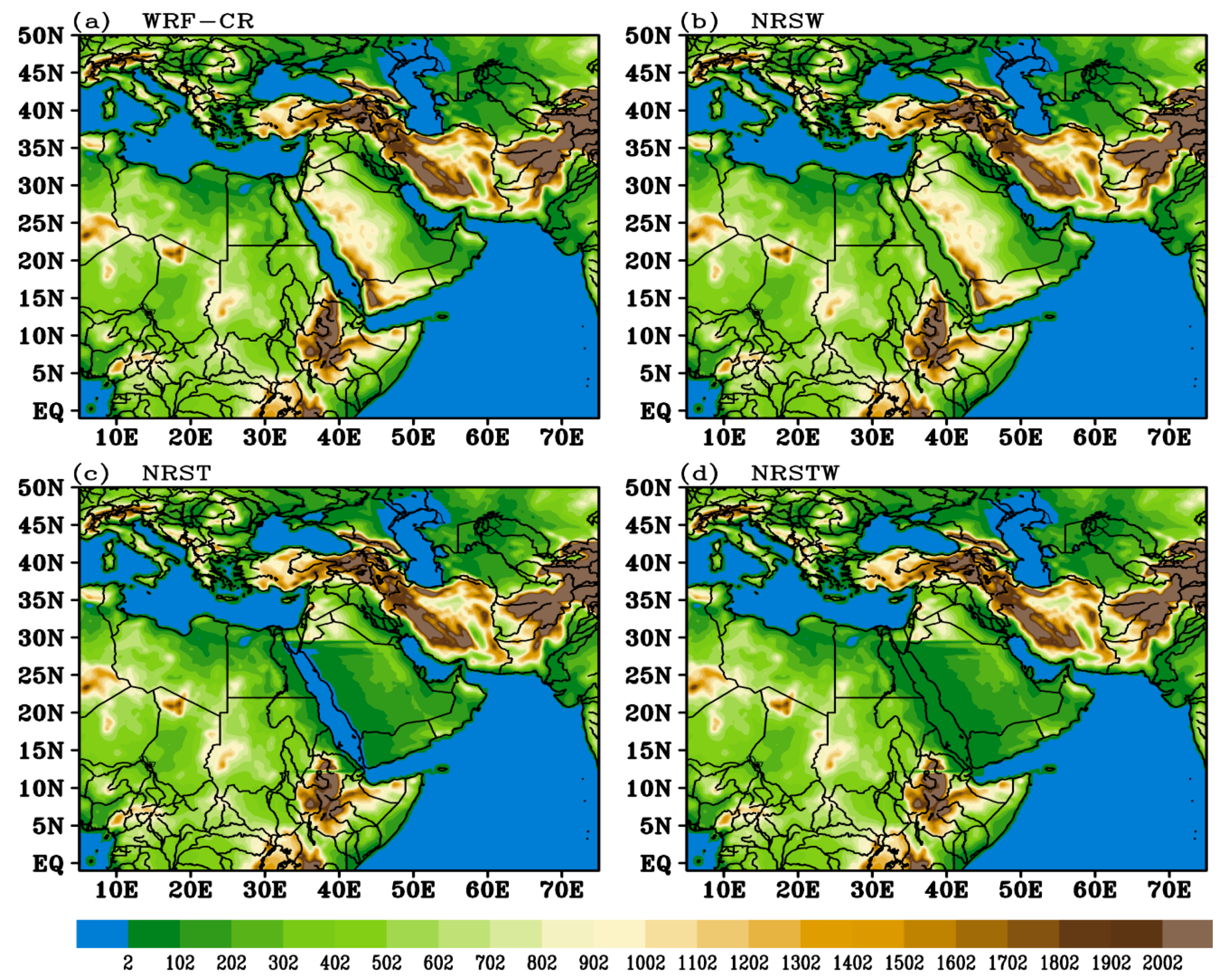
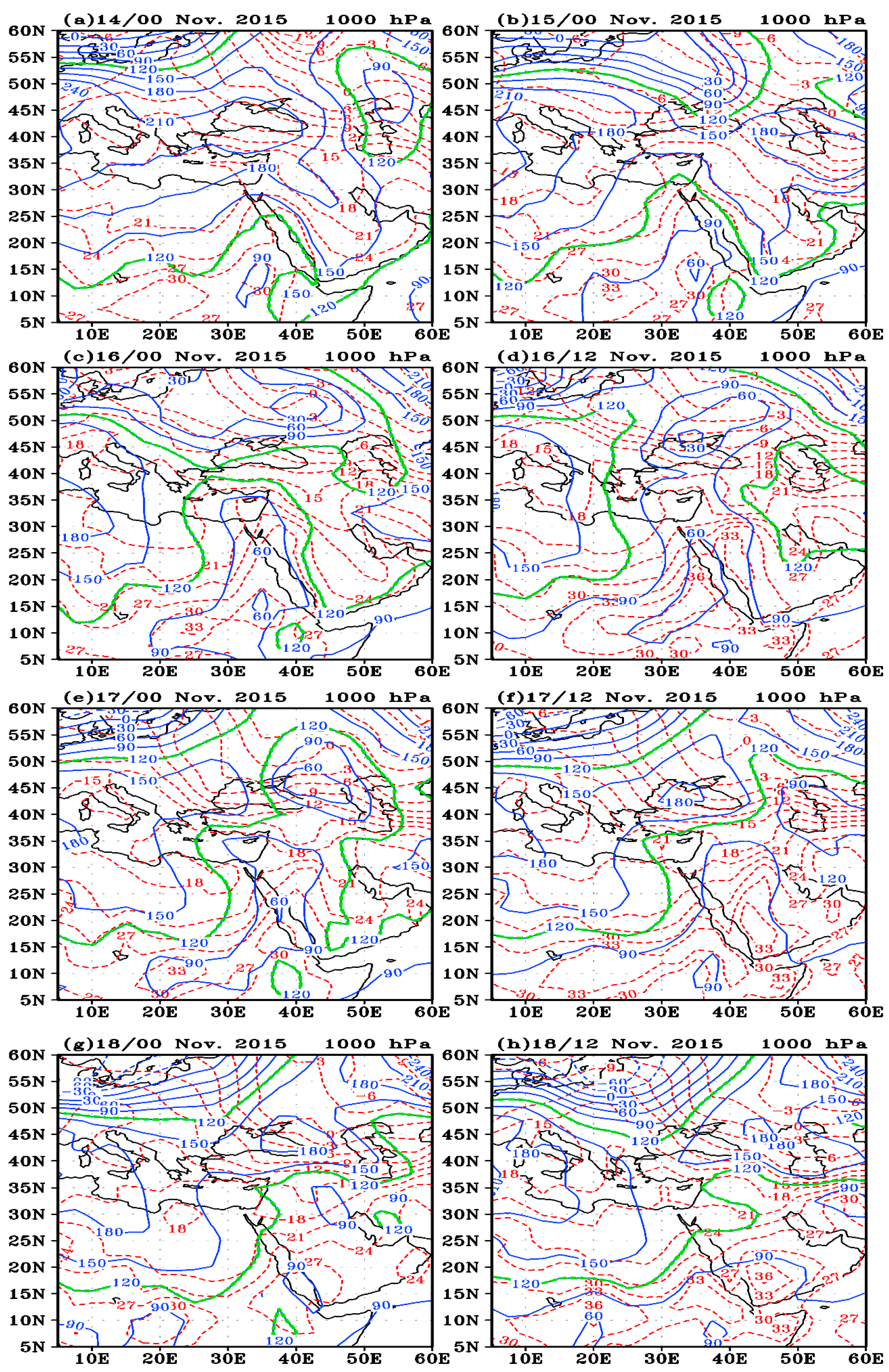

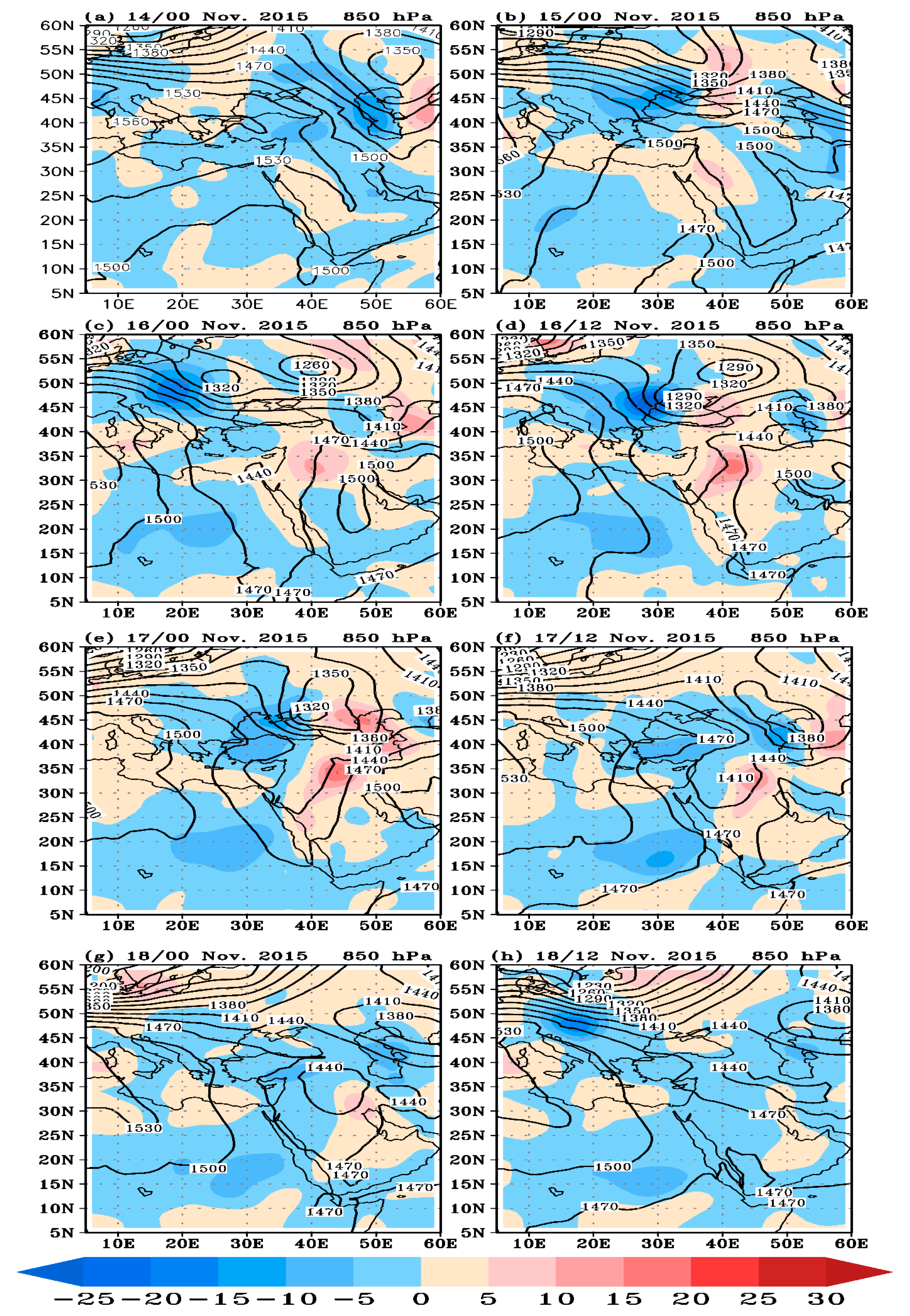

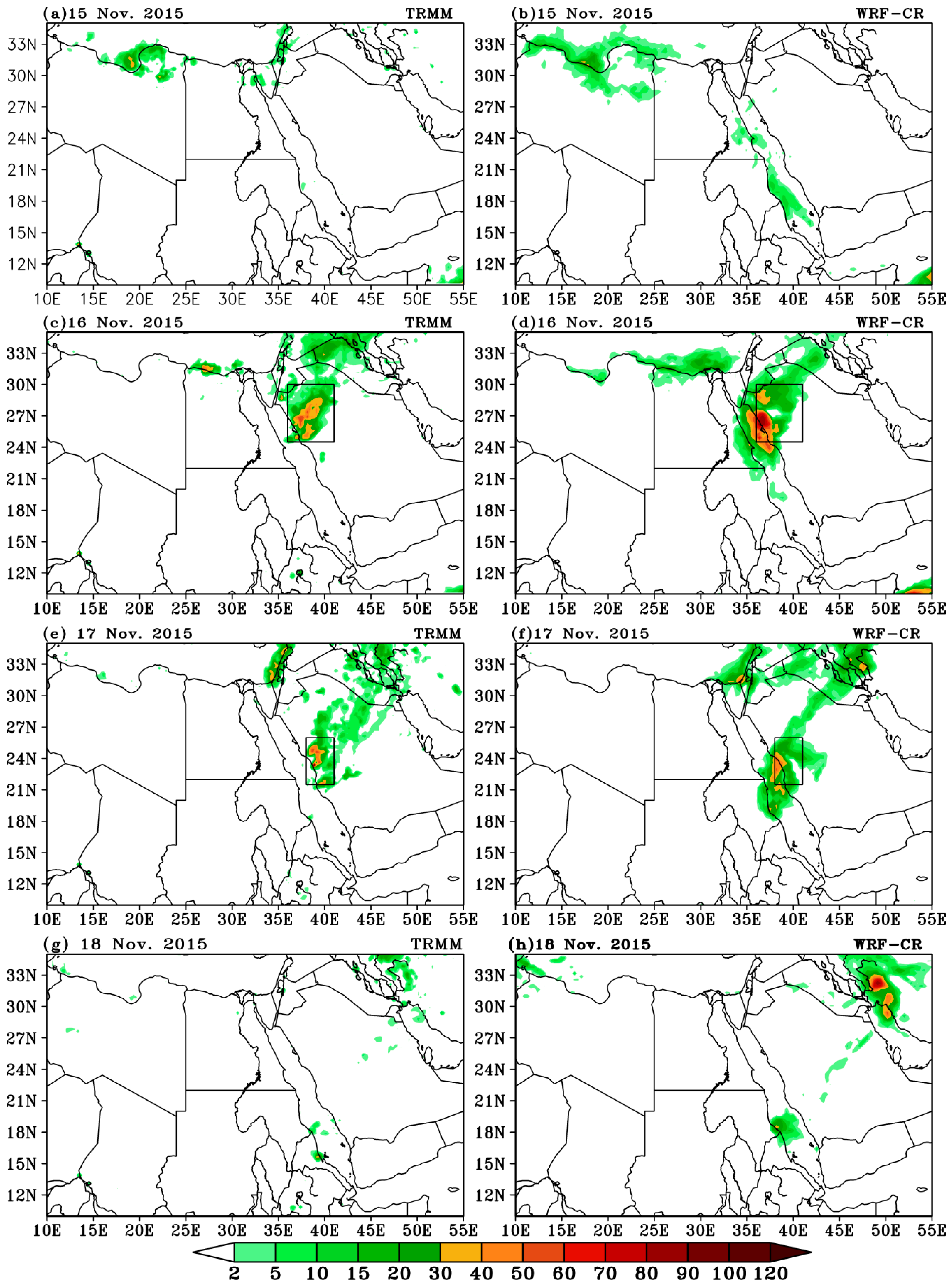
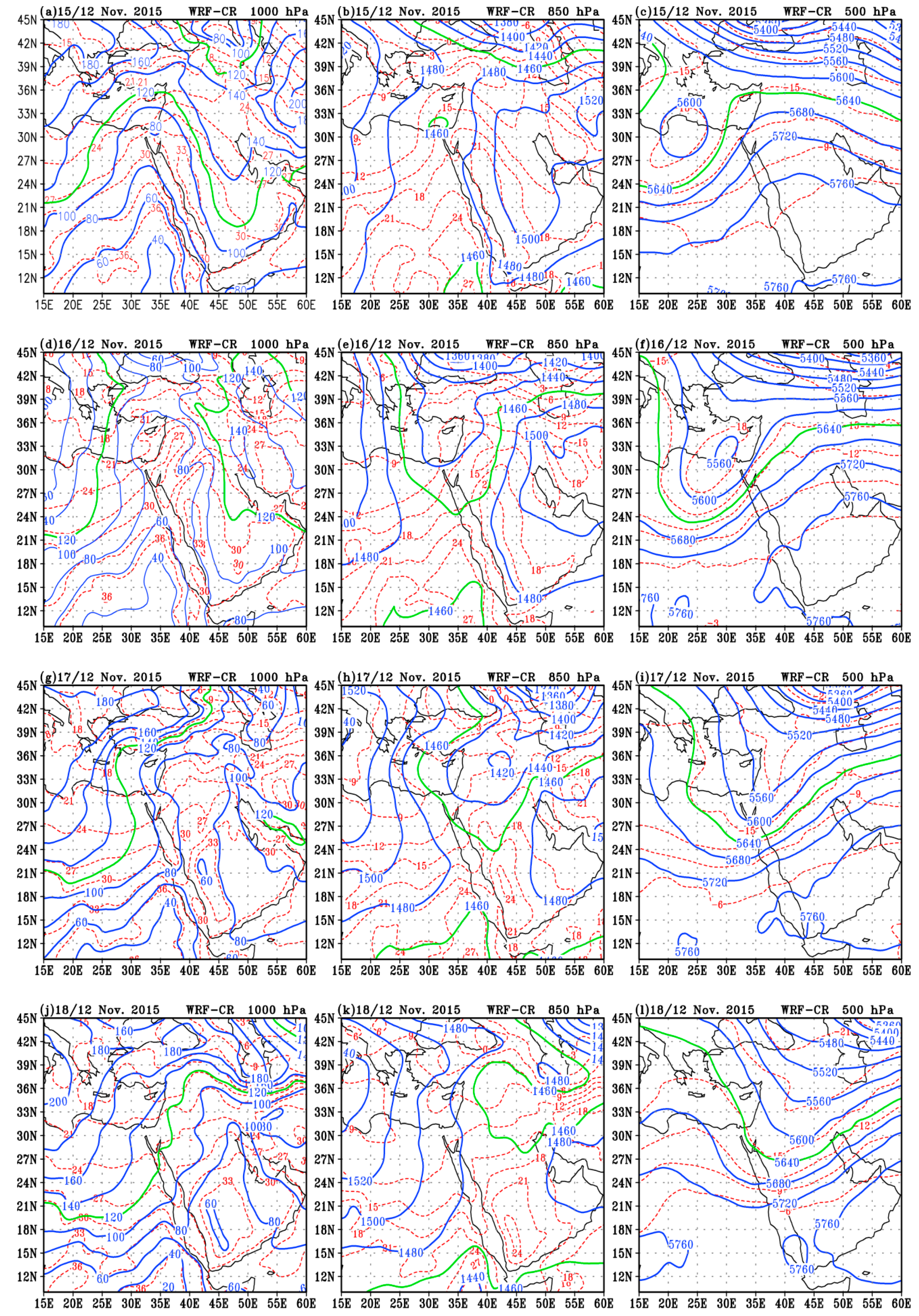

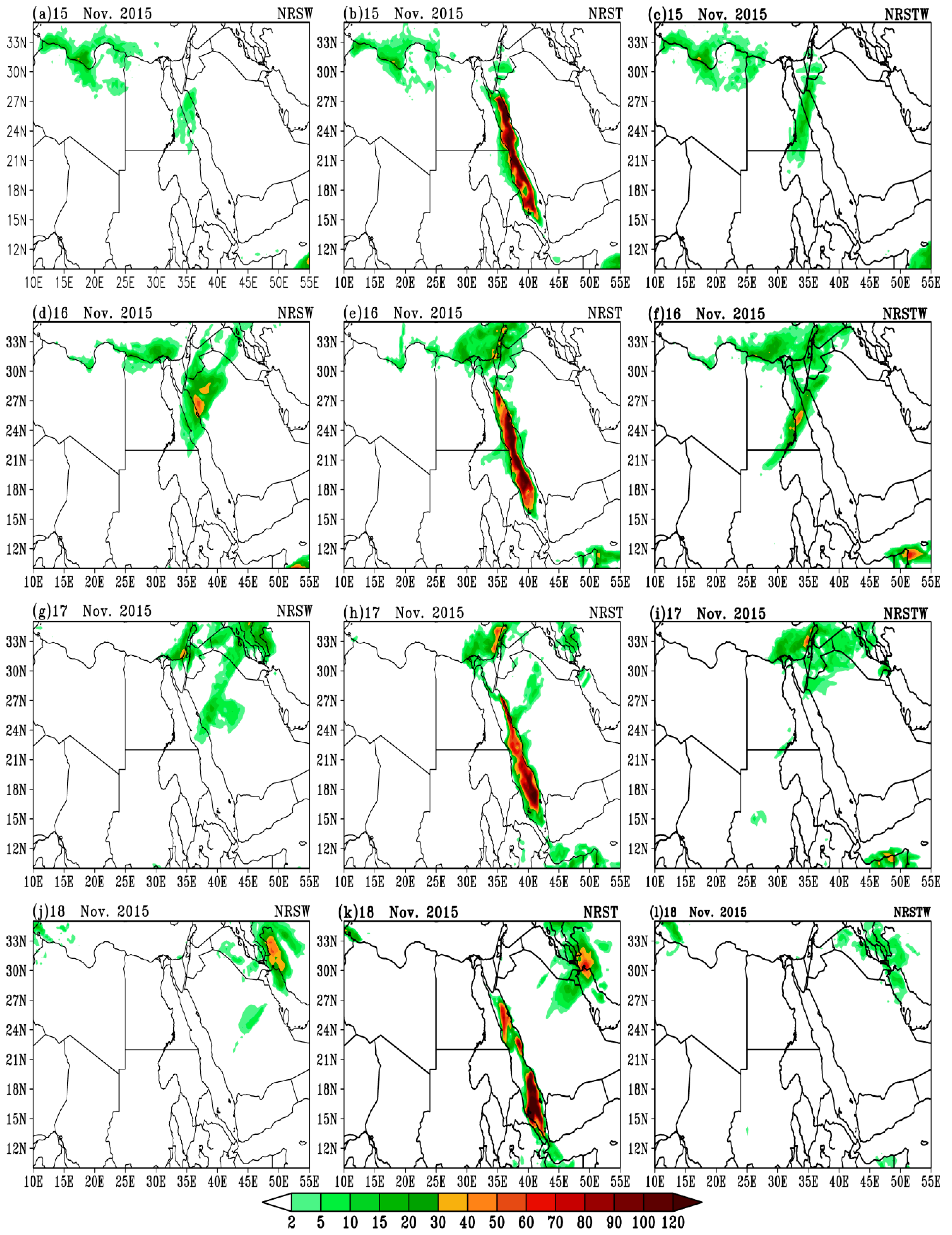
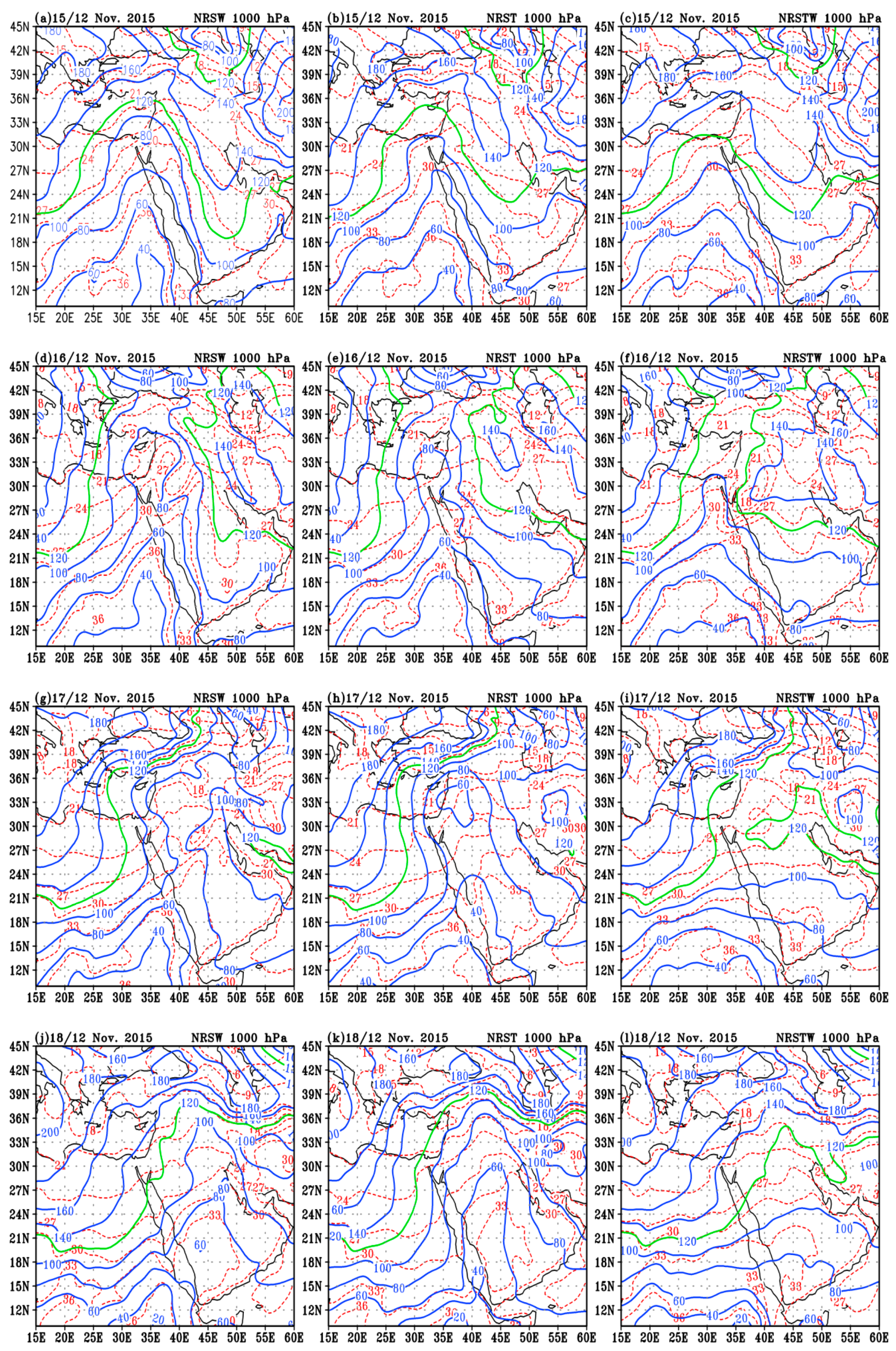
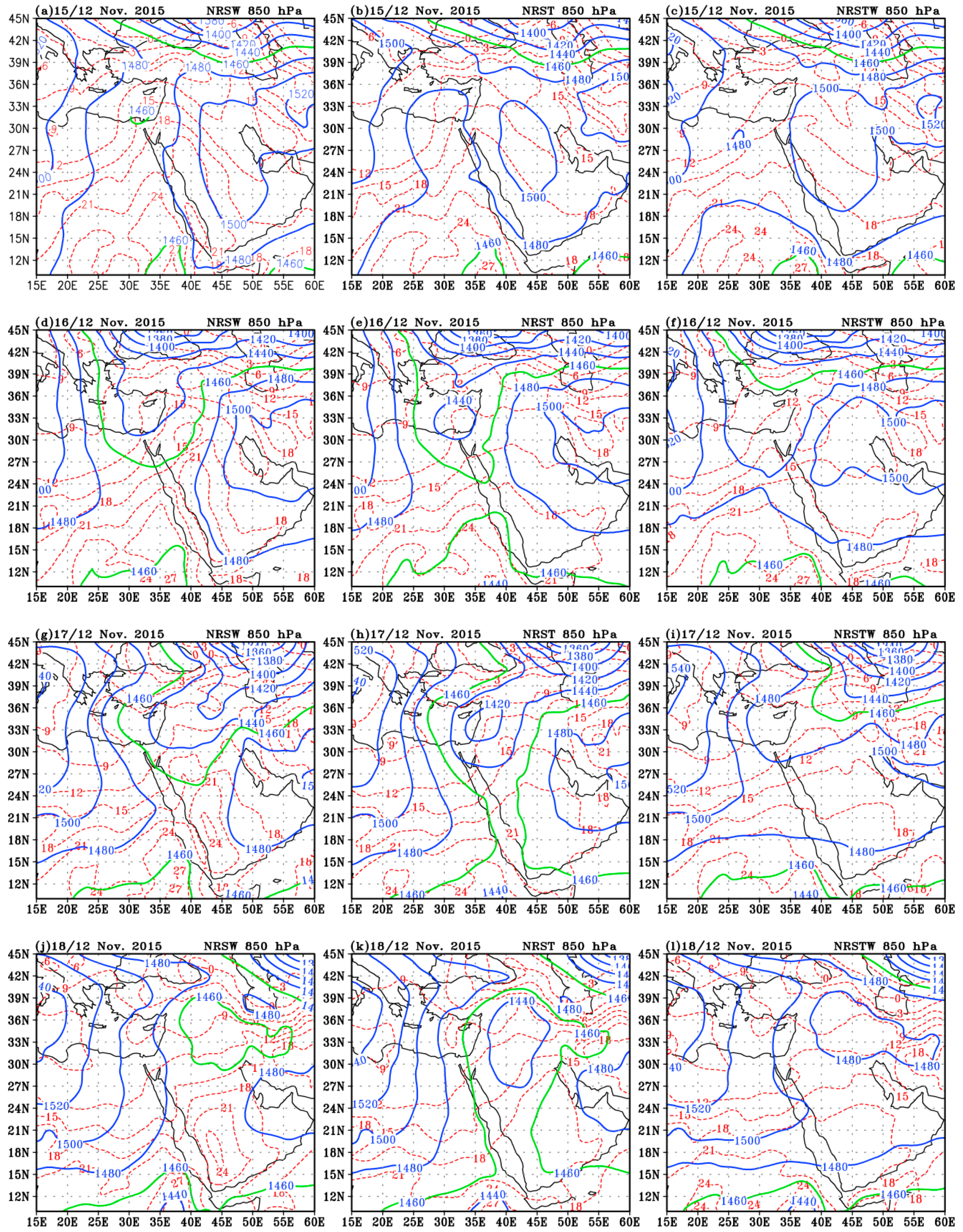
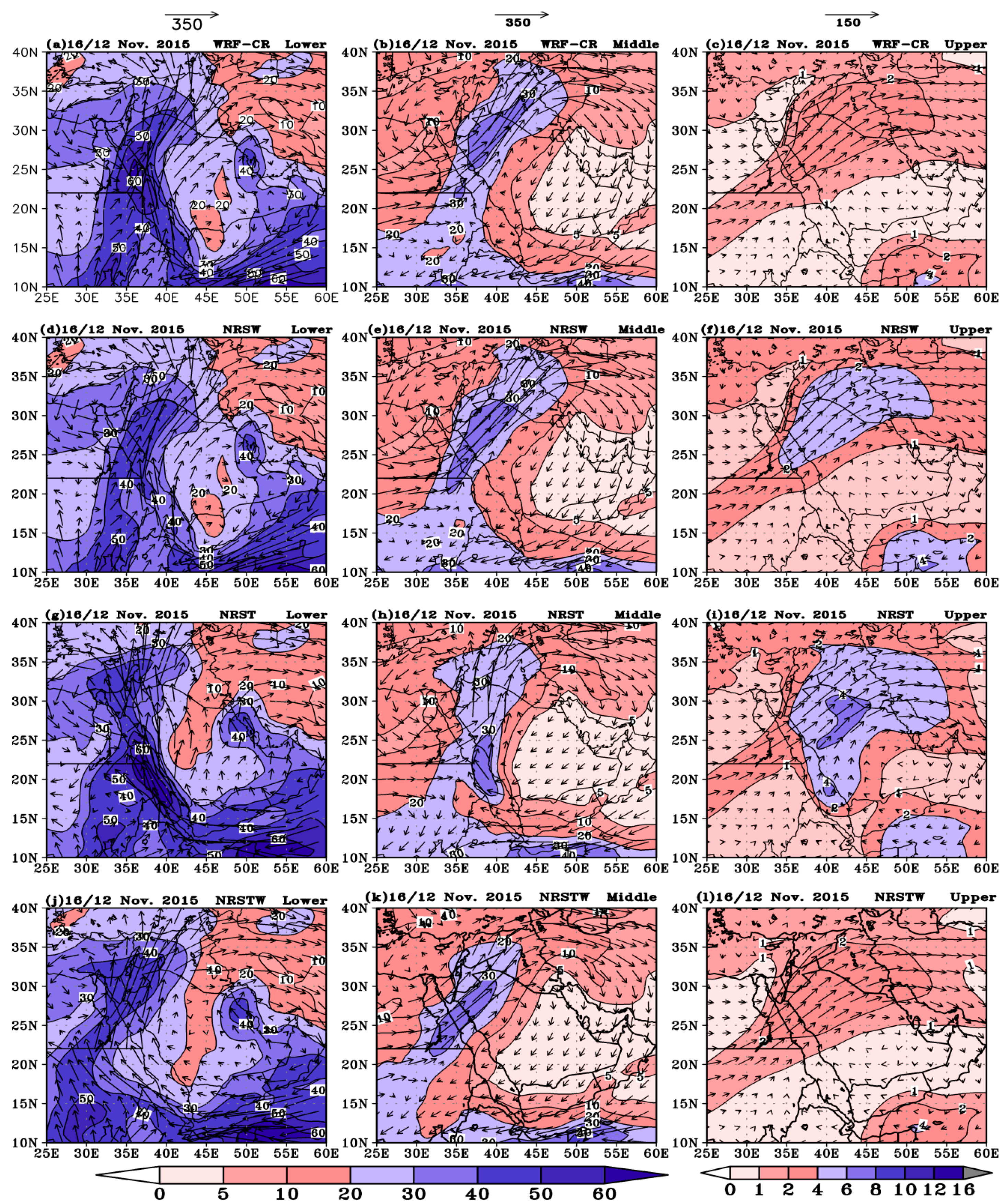
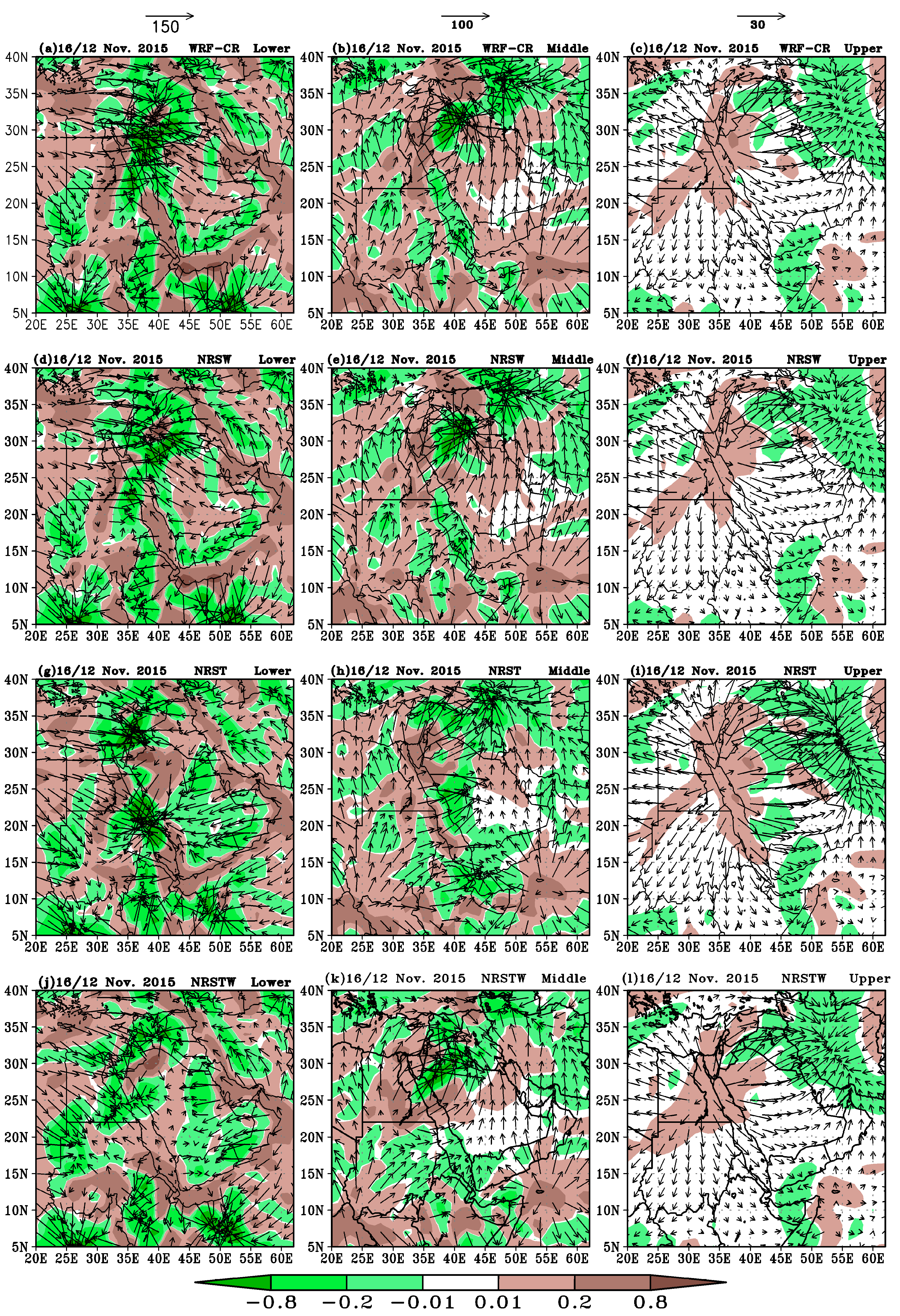

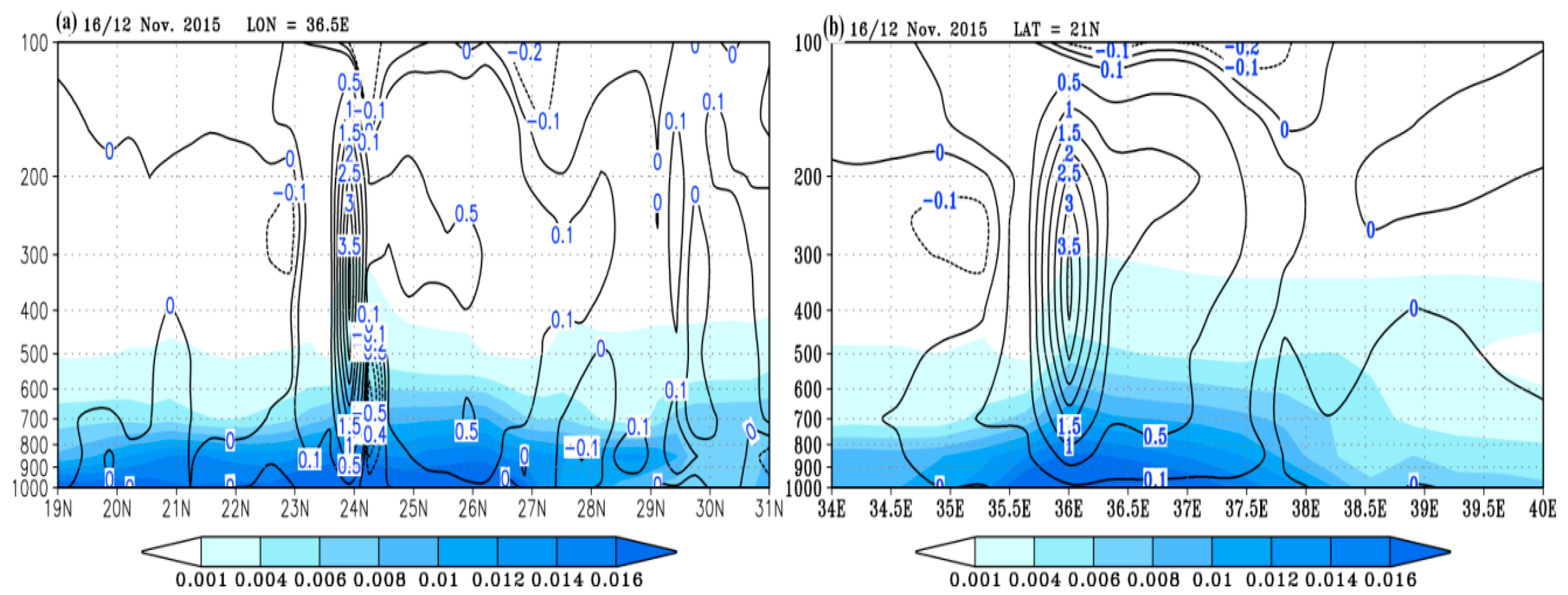
| Variable Name | Modified Value |
|---|---|
| Soil type, Vegetation type, Sand fraction, Clay fraction, Maximum snow albedo, Dominant land use category, Soil temperature, Surface humidity mixing ratio, Surface temperature, Surface potential temperature, Skin sea surface temperature. | Equal to the value of the adjacent ground point on the same latitude. |
| Land cover (land) | 1 |
| Annual mean deep soil temperature | 305.118 |
| Dominant category top-layer soil type | 6.0 |
| Dominant category bottom-layer soil type | 6.0 |
| Monthly surface albedo | 38.0 |
| Physics Scheme | Scheme Specification | Physics Option |
|---|---|---|
| Microphysics | Eta (coarse) | mp_physics = 95 |
| Long-wave radiation | RRTMG | ra_lw_physics = 4 |
| Short-wave radiation | RRTMG | ra_sw_physics = 4 |
| Surface Layer | Monin-Obukhov | sf_sfclay_physics = 1 |
| Land Surface | Thermal Diffusion | sf_surface_physics = 1 |
| Planetary boundary-layer | Yonsei University (YSU) | bl_pbl_physics = 1 |
| Cumulus Convection | Kain-Fritsch | cu_physics = 1 |
© 2019 by the authors. Licensee MDPI, Basel, Switzerland. This article is an open access article distributed under the terms and conditions of the Creative Commons Attribution (CC BY) license (http://creativecommons.org/licenses/by/4.0/).
Share and Cite
Al-Mutairi, M.; Abdel Basset, H.; Morsy, M.; Abdeldym, A. On the Effect of Red Sea and Topography on Rainfall over Saudi Arabia: Case Study. Atmosphere 2019, 10, 669. https://doi.org/10.3390/atmos10110669
Al-Mutairi M, Abdel Basset H, Morsy M, Abdeldym A. On the Effect of Red Sea and Topography on Rainfall over Saudi Arabia: Case Study. Atmosphere. 2019; 10(11):669. https://doi.org/10.3390/atmos10110669
Chicago/Turabian StyleAl-Mutairi, Motirh, Heshmat Abdel Basset, Mostafa Morsy, and Abdallah Abdeldym. 2019. "On the Effect of Red Sea and Topography on Rainfall over Saudi Arabia: Case Study" Atmosphere 10, no. 11: 669. https://doi.org/10.3390/atmos10110669
APA StyleAl-Mutairi, M., Abdel Basset, H., Morsy, M., & Abdeldym, A. (2019). On the Effect of Red Sea and Topography on Rainfall over Saudi Arabia: Case Study. Atmosphere, 10(11), 669. https://doi.org/10.3390/atmos10110669





